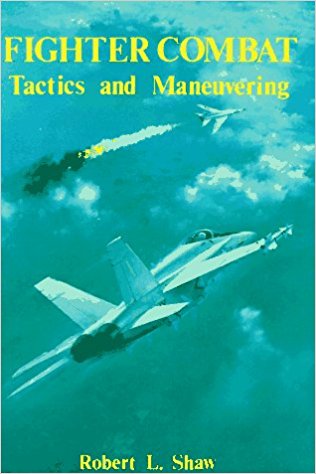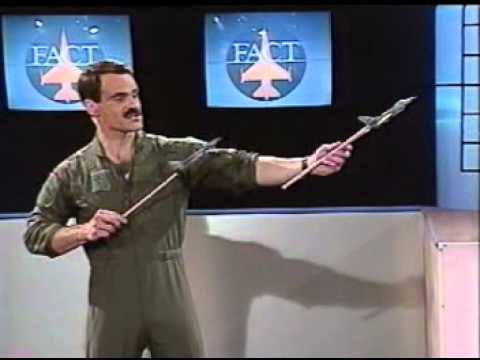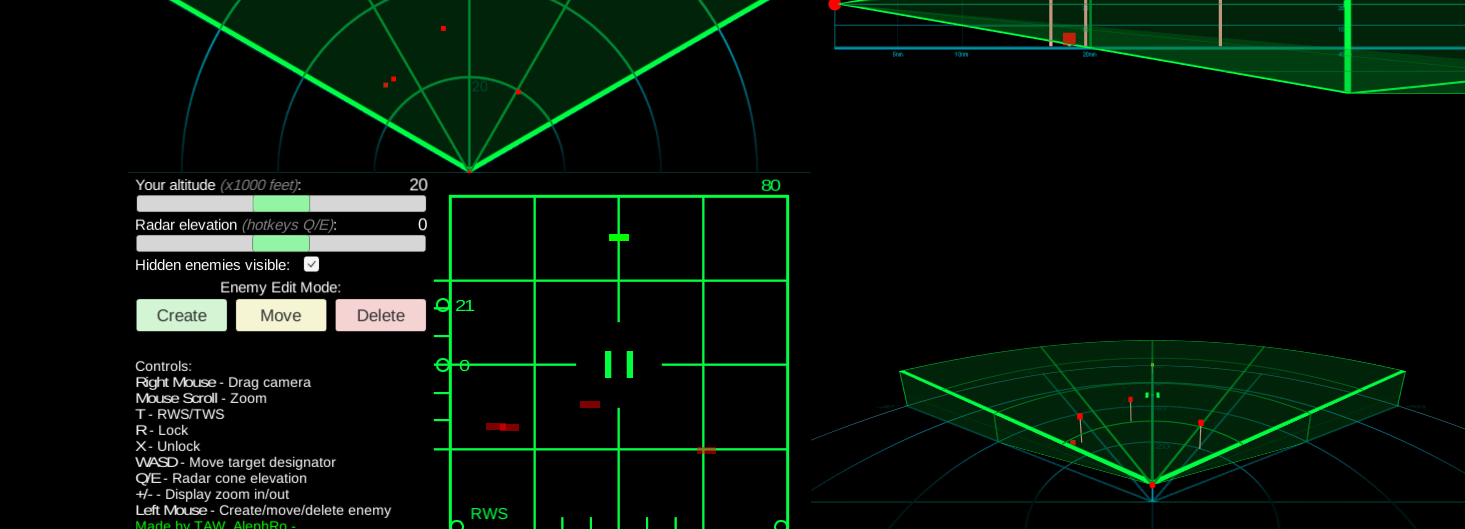Difference between revisions of "Air-to-Air Combat"
| (One intermediate revision by the same user not shown) | |||
| Line 9: | Line 9: | ||
__TOC__ | __TOC__ | ||
| − | =Basics= | + | ---- |
| + | |||
| + | =Basics: What is Energy?= | ||
Perhaps the most important factor in every aspect of fighting against other aircraft (and even against ground based threats) is the notion of '''energy (fighting)''': the state of energy of a given aircraft can often make or break an engagement. | Perhaps the most important factor in every aspect of fighting against other aircraft (and even against ground based threats) is the notion of '''energy (fighting)''': the state of energy of a given aircraft can often make or break an engagement. | ||
| Line 61: | Line 63: | ||
As mentioned before, '''Beyond Visual Range (BVR)''' is the opening stage of virtually any aerial battle and takes place at ranges beyond which we can see (as the name suggests and/or duh), classified as at over 20 nautical miles range ('''>20 nm'''). This means that we need some type of guidance to actually engage our targets / find them for fighting them Within Visual Range (WVR). | As mentioned before, '''Beyond Visual Range (BVR)''' is the opening stage of virtually any aerial battle and takes place at ranges beyond which we can see (as the name suggests and/or duh), classified as at over 20 nautical miles range ('''>20 nm'''). This means that we need some type of guidance to actually engage our targets / find them for fighting them Within Visual Range (WVR). | ||
| − | This is where radar comes into play, either by the use of an aircraft that has on-board radar, a supporting AWACS aircraft (Airborne Warning And Control System) or by the use of a GCI (Ground Control Intercept); via radar we / they detect possible hostiles, also known as ''contacts'', which can then be intercepted via the use of launching radar-guided missiles. | + | This is where radar comes into play, either by the use of an aircraft that has on-board radar, a supporting AWACS aircraft (Airborne Warning And Control System) or by the use of a GCI (Ground Control Intercept); via radar we / they detect possible hostiles, also known as ''contacts'', which can then be intercepted via the use of launching radar-guided missiles. In layman's terms radar works by sending out a signal in the radio spectrum (above 300 MHz, or 300 000 000 Hertz) which reflects off of any targets, and is reflected back to the radar (receiver); similar to how in a still water dropping a rock produces ripple waves, that bounce off of any object floating in the pond and reflect back. We can distinguish targets by comparing the reflected signals bouncing off the target to the radar waves that went straight on, as there is a difference in reflected radar waves off the target and not getting radar waves back at all, or at a delay (when bouncing off the mountain behind the plane). |
| + | |||
| + | Alternative to using radar we could also track our targets with the use of detecting their heat signature, which is generated primarily by the use of their fuel burning engines (and especially if they are using their afterburners). Similar to the radar example above, there is a difference between the large heat source and the surrounding air; the difference with radar is that we can measure the heat radiating off of the | ||
| + | |||
| + | |||
| + | Please refer to the 'Radar Operation' section of this page on the (more accurate) operating principles of radar, and the different types of (radar / infrared) missiles. | ||
---- | ---- | ||
| Line 130: | Line 137: | ||
=Radar Operation= | =Radar Operation= | ||
| + | |||
| + | =Defensive Operations= | ||
=Further Reading Material= | =Further Reading Material= | ||
Latest revision as of 16:27, 26 October 2018
This page is dedicated to learn you the art of fighting against other aircraft, be it aircraft controlled by other human pilot or versus AI (computer controlled). Be wary that although most of this material can give you a good insight into how aerial combat is done, the most effective (and for some frustrating) way of learning is to try and fight others (be it AI or human). You might lose a number of times, but you will gain the experience from it. Practice makes perfect!
Contents
Basics: What is Energy?
Perhaps the most important factor in every aspect of fighting against other aircraft (and even against ground based threats) is the notion of energy (fighting): the state of energy of a given aircraft can often make or break an engagement.
Energy is the sum total amount of power you can express at a given time (and you ideally want as much as possible at any time). Primarily the amount of energy or energy state is dependent on how you chose to fly your aircraft: if you make a hard 9G turn you will bleed a lot of energy, versus a 3G turn that keeps you in a pure pursuit that will only lose you a small amount of energy.
However, energy is also influenced by the state of many smaller factors:
- 1. Speed / velocity
- Perhaps the most basic of all energy factors, the amount of speed (velocity) an aircraft has is manipulated by the amount of thrust put out, or the amount of altitude traded in. Be wary that drag and weight are detrimental to speed, as they severely restrict your ability to obtain or maintain speed.
- 2. Altitude
- Altitude can be easily overlooked as a given thing, but it is in actuality one of the factors you will largely be manipulating (subconsciously) during aerial combat. This is because you are often trading in velocity for altitude and vice versa.
- 3. Drag
- The amount of drag is how much air resistance an aircraft encounters (similar to sticking your hand outside the window of a moving car). Typically drag is encountered due to the stores carried on the aircraft or things such as flaps, air brakes being deployed, as aircraft designers make their aircraft as aerodynamic (almost no drag) as possible.
- 4. Fuel
- An aircraft needs fuel to fly, so you might be keen to take as much of it as possible. A lot of fuel will however equate to a lot of extra weight on the aircraft, so you are either not going to turn as quickly or lose a lot of speed (energy) whilst making that turn. You could use that fuel to obtain extra speed (light those afterburners!) during a fight though.
- 5. Weight
- Typically weight is one of the most influential factors on the energy state, as altering the weight also has an effect on other factors (ie thrust to weight ratio). You can jettison your fuel tanks or weapons to shed weight, but be mindful of the fact you may need them later.
- 6.
- 7. Miscellaneous
- Sometimes there are extraordinary actions / items that you can bring to the table to gain an edge in the (energy) fighting, that are not classified by the parameters above. Examples of such feats can be the SPRD-99 Rocket Booster for the Mig-21 (allowing you a temporary boost in power) or the 'Viffing' technique in the AV-8B N/A Harrier (where you rotate your nozzles downward in a turn to gain a increase in turn rate).
What is important to note here is that many of these factors share a relationship (be it positive or negative): if you have a lot of fuel (and thus weight), you can trade this in for speed by applying more power to your engines. Subsequently you can trade in that speed for more altitude. Equally, if you have too much weight on your aircraft you could opt to jettison a number of stores to lighten the load of your aircraft.
As you can see energy fighting is a ballet of precisely weighing the effect of one of these factors against others, and trying to obtain the best combination of all of them will dramatically increase your chances against other aircraft. For example, dumping extra weight in the form of fuel and weaponry is going to significantly increase your thrust to weight ratio, making your aircraft turn harder, fly faster and loose less energy doing so (you might however end up needing those missiles you just jettison'ed).
Careful energy management is key in all of the different aspects of aerial combat, whether your target be far away or be right on your 6 o'clock. Prior to the introduction of radar and missiles fights often started as soon as you could visually identify your target (or was told by your ground intercept where you would want to fly to intercept the bad guys). A head on pass with guns was often the opening salvo, after which the fight devolved into a series of Basic Fighter Manoeuvres (BFM) in a so-called dogfight, with all aircraft involved trying to register hits and kill the opponent by shooting guns.
However with the introduction of on-board radar and missiles the game changed somewhat. Although close-in fights are still common occurrence, the opening stages of the battle now takes place by lobbing (radar guided) missiles at one another from afar, before we even get into visual range of one another. This process of lobbing missiles (now both radar guided and infrared) typically continues well into the visual range domain, until either one the sides partaking in the conflict has no aircraft left flying, or until we reach the range required for dog fighting / aerial gunnery.
| Range definition | DCS Range (nm |
|---|---|
| BVR | >= 20 nm |
| WVR | 3 ~ 20 nm |
| Dog Fighting | < 3 nm |
Beyond Visual Range (BVR)
As mentioned before, Beyond Visual Range (BVR) is the opening stage of virtually any aerial battle and takes place at ranges beyond which we can see (as the name suggests and/or duh), classified as at over 20 nautical miles range (>20 nm). This means that we need some type of guidance to actually engage our targets / find them for fighting them Within Visual Range (WVR).
This is where radar comes into play, either by the use of an aircraft that has on-board radar, a supporting AWACS aircraft (Airborne Warning And Control System) or by the use of a GCI (Ground Control Intercept); via radar we / they detect possible hostiles, also known as contacts, which can then be intercepted via the use of launching radar-guided missiles. In layman's terms radar works by sending out a signal in the radio spectrum (above 300 MHz, or 300 000 000 Hertz) which reflects off of any targets, and is reflected back to the radar (receiver); similar to how in a still water dropping a rock produces ripple waves, that bounce off of any object floating in the pond and reflect back. We can distinguish targets by comparing the reflected signals bouncing off the target to the radar waves that went straight on, as there is a difference in reflected radar waves off the target and not getting radar waves back at all, or at a delay (when bouncing off the mountain behind the plane).
Alternative to using radar we could also track our targets with the use of detecting their heat signature, which is generated primarily by the use of their fuel burning engines (and especially if they are using their afterburners). Similar to the radar example above, there is a difference between the large heat source and the surrounding air; the difference with radar is that we can measure the heat radiating off of the
Please refer to the 'Radar Operation' section of this page on the (more accurate) operating principles of radar, and the different types of (radar / infrared) missiles.
Within Visual Range (WVR)
Dog Fighting
Dog Fighting (sometimes called aerial gunnery) is technically sub-part of the Within Visual Range (WVR), but
Basic Fighter Maneuvers (BFM)
Simple BFM
Combat Spread / Formation
Defensive Split
Sandwich
Break
Barrel Roll Attack
High-side Gun Pass
Immelman
Split-S
Pitchback
Wingover
Chandelle
Thach Weave
Complex BFM
High Yo-Yo
Low Yo-Yo
Lag Displacement Roll
Pugachev Cobra
Cobra Turn
Kulbit
Herbst Maneuvre
Unloaded extension
Guns Defense
Defensive Spiral
Radar Operation
Defensive Operations
Further Reading Material
Books/PDF
Fighter Combat: Tactics and Maneuvering - 80's era book on BFM/BVR combat, placing it in the perfect timeframe for applicability to DCS World fights.
Ktulu2's BVR Guide - F-15C centric, but many of the concepts work across all aircraft.
DCS F-15 Combat Guide Excellent discription of how radar works, and how to tackle an engagement



